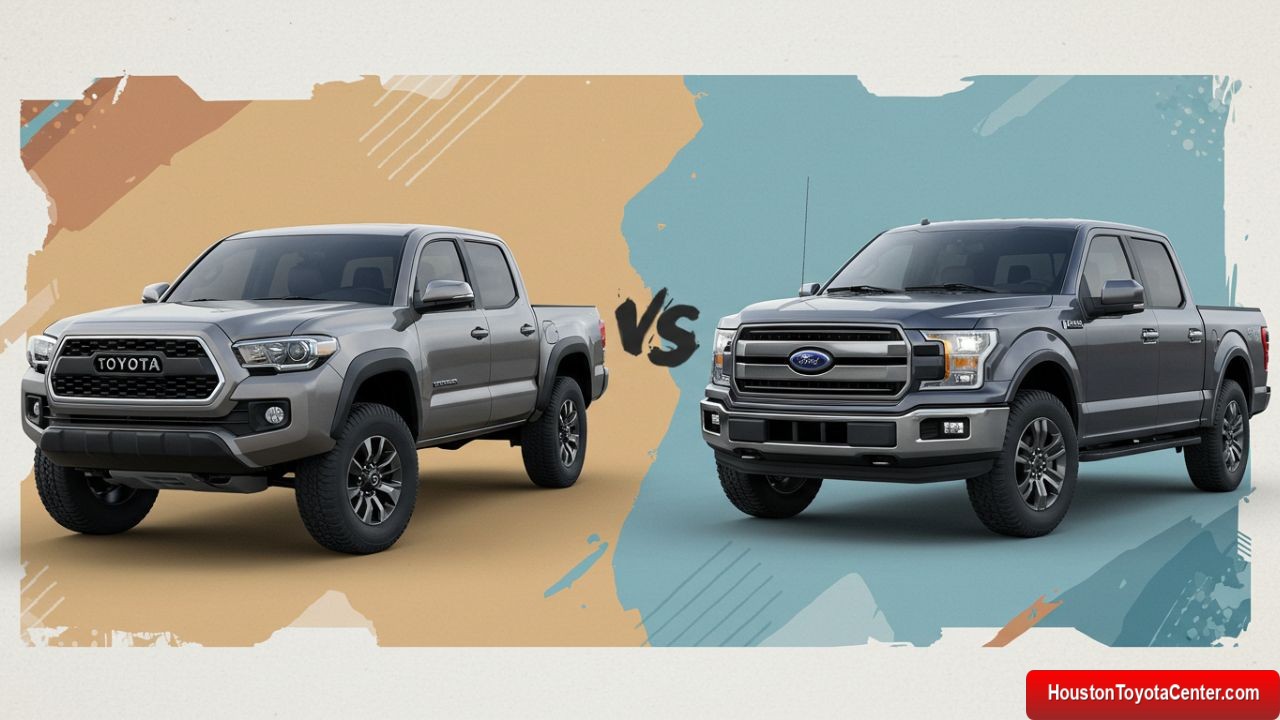When it comes to pickup trucks, two names dominate conversations: the Toyota Tacoma and the Ford F-150. While the Tacoma is a midsize truck beloved for its off-road prowess and reliability, the F-150 is a full-size titan known for raw power, innovation, and versatility. Choosing between them isn’t just about size—it’s about matching your lifestyle, needs, and budget. In this comprehensive comparison, we dive deep into performance, capability, technology, safety, and value to help you decide which truck reigns supreme.
1. Performance: Power vs. Precision
Both trucks cater to different audiences, and their performance specs reflect that.
Engine Options
- Toyota Tacoma:
- Base engine: 2.7L 4-cylinder (159 hp, 180 lb-ft torque).
- Upgrade: 3.5L V6 (278 hp, 265 lb-ft torque).
- Hybrid option: Not available (as of 2023).
- Transmission: 6-speed automatic or 6-speed manual (TRD models).
- Ford F-150:
- Base engine: 3.3L V6 (290 hp, 265 lb-ft torque).
- Mid-tier: 2.7L EcoBoost V6 (325 hp, 400 lb-ft torque).
- High-performance: 3.5L PowerBoost Hybrid (430 hp, 570 lb-ft torque).
- Transmission: 10-speed automatic.
Key Takeaway: The F-150 offers superior horsepower and torque, especially with its turbocharged and hybrid engines. The Tacoma’s manual transmission option, however, appeals to driving purists.
Towing and Payload
Towing and payload capacity are critical for truck buyers. Here’s how they stack up:
FREE: Quickly identify and understand problems with your vehicle 🚘
CLICK HERE| Metric | Toyota Tacoma | Ford F-150 |
|---|---|---|
| Max Towing Capacity | 6,800 lbs | 14,000 lbs |
| Max Payload Capacity | 1,685 lbs | 3,325 lbs |
| Engine for Max Tow | 3.5L V6 | 3.5L PowerBoost |
The F-150’s Pro Trailer Backup Assist and integrated trailer brake controller make heavy towing effortless. The Tacoma, while capable for midsize adventures, can’t compete with the F-150’s heavy-duty specs.
2. Off-Road Capabilities: Trail vs. Terrain
If off-roading is your priority, both trucks have specialized trims—but they cater to different terrains.
Toyota Tacoma TRD Pro
- Features:
- Fox Internal Bypass Shock Absorbers.
- Multi-Terrain Select (MTS) and Crawl Control.
- Skid plates, LED fog lights, and all-terrain tires.
- Approach Angle: 32° | Departure Angle: 24°.
Ford F-150 Tremor/Raptor
- F-150 Tremor:
- 35-inch tires, electronic locking rear differential.
- Trail Turn Assist (reduces turning radius).
- Approach Angle: 27.6° | Departure Angle: 24.3°.
- F-150 Raptor:
- 37-inch tires, FOX Live Valve shocks.
- 450 hp twin-turbo V6, Baja Mode for desert racing.
- Approach Angle: 33.1° | Departure Angle: 24.9°.
Verdict: The Tacoma TRD Pro is ideal for technical trails, while the F-150 Raptor dominates high-speed desert runs.
3. Interior Comfort and Technology
Daily drivers need comfort and connectivity. Let’s compare cabins and tech.
Toyota Tacoma
- Pros:
- Durable, water-resistant upholstery (TRD models).
- 7-inch touchscreen (optional 8-inch).
- Apple CarPlay, Android Auto, and Wi-Fi hotspot.
- Cons:
- Outdated interior design.
- Cramped rear seating.
Ford F-150
- Pros:
- Available 12-inch SYNC 4 touchscreen.
- Leather seats with massaging function (Platinum trim).
- Onboard generator (Pro Power Onboard up to 7.2 kW).
- Cons:
- Higher trims get pricey quickly.
Tech Comparison Table:
| Feature | Tacoma | F-150 |
|---|---|---|
| Largest Touchscreen | 8″ | 12″ |
| Wireless Charging | Optional | Standard (Higher Trims) |
| Digital Gauge Cluster | No | 12″ Optional |
| Hybrid Powertrain | No | Yes |
4. Safety: Toyota Safety Sense vs. Ford Co-Pilot 360
Safety is non-negotiable. Both trucks offer advanced suites, but with different focuses.
- Toyota Safety Sense 2.5:
- Includes adaptive cruise control, lane-departure warning, and automatic emergency braking.
- Downside: No blind-spot monitoring on base models.
- Ford Co-Pilot 360 2.0:
- Adds blind-spot monitoring, intersection assist, and Active Drive Assist (hands-free highway driving).
- Bonus: Trailer Coverage Camera for safer towing.
Safety Award: Ford’s hands-free tech and trailer integration give it an edge.
5. Fuel Efficiency and Ownership Costs
Long-term costs matter. Let’s break it down:
| Metric | Tacoma V6 (4WD) | F-150 2.7L EcoBoost (4WD) |
|---|---|---|
| MPG (City/Highway) | 18/22 | 20/24 |
| Annual Fuel Cost* | $2,200 | $1,900 |
| 5-Year Maintenance** | $4,500 | $5,800 |
*Based on 15,000 miles/year. **Estimate from RepairPal.
Insight: The Tacoma’s lower maintenance costs and strong resale value balance its higher fuel consumption.
6. Pricing and Trims: Value for Money
Here’s a breakdown of starting prices and popular trims:
- Toyota Tacoma:
- SR: $28,000
- TRD Off-Road: $36,000
- TRD Pro: $47,000
- Ford F-150:
- XL: $33,000
- Lariat: $48,000
- Raptor: $76,000
Budget Pick: Tacoma SR offers affordability for casual users.
Premium Pick: F-150 Platinum balances luxury and utility.
7. Reliability and Resale Value
Toyota’s reputation for reliability is legendary. According to J.D. Power, the Tacoma scores 85/100 for dependability, while the F-150 scores 78/100. Resale value also favors Toyota: after 5 years, the Tacoma retains 65% of its value vs. the F-150’s 55%.
Final Verdict: Who Should Buy Which?
- Choose the Toyota Tacoma If:
- You prioritize off-road agility.
- Want lower maintenance costs and higher resale value.
- Don’t need heavy towing capacity.
- Choose the Ford F-150 If:
- You require maximum towing/payload.
- Desire cutting-edge tech and luxury.
- Plan to use your truck for mixed roles (work + family).


Leave a Reply